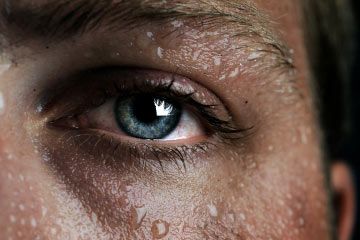Our bodies sweat to maintain a constant, controlled temperature. When you sweat excessively, you may have a condition known as hyperhidrosis that, according to the Mayo Clinic, affects about 2.8 percent of Americans. If this is the case, you'll need something stronger than an over-the-counter roll-on to control odor and wetness.
First, you need to know how your body sweats, and then what products can help minimize it. Your body has two types of glands that manufacture sweat: the eccrine and the apocrine glands. The eccrine glands are in your skin, and these are the glands that pump out most of your sweat, a salty fluid that evaporates to help you cool down. The apocrine glands are found where you have an abundance of hair follicles, such as your scalp, underarms and groin, and they secrete a thicker sweat that is packed full of proteins and fatty acids.
Advertisement
To control excessive underarm wetness, known as axillary hyperhidrosis, doctors advise their patients to try antiperspirants that contain about 15 to 20 percent of an aluminum-based compound. Look for ingredients such as aluminum chloride or aluminum zirconium tricholorhydrex glycine as a primary ingredient -- usually an over-the-counter option. If that doesn't work, prescription strength antiperspirants that contain levels of aluminum-based ingredients higher than over-the-counter types (as high as 20 to 25 percent or greater) may be the way to go.
Antiperspirants help control wetness. They often contain aluminum salts as a main ingredient: Aluminum stops sweat by plugging sweat ducts. This also helps reduce body odor -- less sweat means less odor. Deodorants, on the other hand, are designed to mask body odor. They don't stop wetness. Deodorants contain ingredients to change the way your body smells, and some do so with an ingredient called triclosan. Triclosan is an antimicrobial agent, which means it reduces the growth of bacteria and other microorganisms, that's added to everything from furniture and toys to toothpaste and deodorant. By reducing the number of bacteria on your skin, triclosan-based deodorants control body odor.
Sweat doesn't naturally smell bad. It's not until the sweat meets the bacteria living on your skin that you start to stink -- the smell is a byproduct of bacteria metabolizing sweat. Applying an antimicrobial substance like triclosan to your underarms changes the prevalence of axillary flora, the bacteria that live in the underarm area. Having fewer bacteria reduces the amount of total metabolic waste produced by the bacteria, in turn reducing the strength of your body odor.
Checking to see if an over-the-counter deodorant contains triclosan is easy: Look for it in the ingredient list in the box marked "Drug Facts" on the product label.
Advertisement



